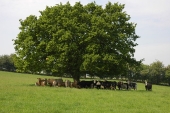
 1
1




 1
1




Idle dreamer
 1
1




 1
1




Idle dreamer




















Idle dreamer








Idle dreamer




 1
1




 ). Much of our grass was non-native King Ranch Bluestem, but most of that died out in the horrible drought a few years ago, and the native grasses are taking over. I plan to pasture chickens in paddocks to clear small patches in which to plant native seed mixes which contain species with seeds for the birds. I expect it will take 5 - 10 years to get our fields looking as we hope, with native grasses interspersed with clumps of wildflowers and wildlife food plants. We also hope to encourage more meadow edge habitat by fencing to allow native shrubs and small trees to regrow. The browsing pressure from our sheep and the insane number of deer here makes it difficult to grow anything without fencing. Our hope is that eventually there will be such density of high quality native food plants that we'll be able to remove some of the fencing and everything won't get eaten down.
). Much of our grass was non-native King Ranch Bluestem, but most of that died out in the horrible drought a few years ago, and the native grasses are taking over. I plan to pasture chickens in paddocks to clear small patches in which to plant native seed mixes which contain species with seeds for the birds. I expect it will take 5 - 10 years to get our fields looking as we hope, with native grasses interspersed with clumps of wildflowers and wildlife food plants. We also hope to encourage more meadow edge habitat by fencing to allow native shrubs and small trees to regrow. The browsing pressure from our sheep and the insane number of deer here makes it difficult to grow anything without fencing. Our hope is that eventually there will be such density of high quality native food plants that we'll be able to remove some of the fencing and everything won't get eaten down.
Idle dreamer
 2
2









Idle dreamer









Idle dreamer








You could try this: http://learningstore.uwex.edu/assets/pdfs/A3715.pdfJoe Paul wrote:Hi all, we currently have a pasture already sown with seeds for sheep/cattle (plantains and rye grasses) and are grazing sheep, cattle, pigs, and geese on this successfully. We wanted to explore the possibility of adding a lot more diversity to the pasture to make it more sustainable and offer a wider range of grazing for all these animals - how does one go about doing that? Do you just sow over-top and hope the additional seeds will take root? Is there a certain list of seeds one should consider when starting to make such a transition?
"Permaculture is a philosophy of working with, rather than against nature; of protracted & thoughtful observation rather than protracted & thoughtless labour; & of looking at plants & animals in all their functions, rather than treating any area as a single-product system."-Bill Mollison




Idle dreamer




 It looks as if you went without the traditional fence posts too unless I truly am blind? Have you found it to hold up well to sheep pressure? One thing a lot of people do not realize about deer is that in order to clear a fence, as graceful jumpers as they are, they need a clear take off and landing zone. Take away the landing zone with a double fence and they are deterred with a fence that does not have to be 8 feet high (and an expense to match). Just a thought as you said deer are prolific there. Maybe your fence style would work strung up in double rows???
It looks as if you went without the traditional fence posts too unless I truly am blind? Have you found it to hold up well to sheep pressure? One thing a lot of people do not realize about deer is that in order to clear a fence, as graceful jumpers as they are, they need a clear take off and landing zone. Take away the landing zone with a double fence and they are deterred with a fence that does not have to be 8 feet high (and an expense to match). Just a thought as you said deer are prolific there. Maybe your fence style would work strung up in double rows???




Idle dreamer








Idle dreamer





|
Morgan Freeman narrated the birth and life of this tiny ad:
Homestead Pigs Course
https://permies.com/wiki/365748/Homestead-Pigs
|




